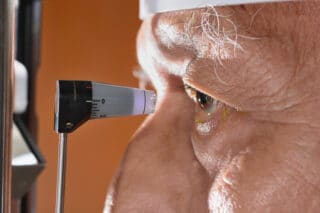
NewView Laser Eye, Inc.
12110 Sunset Hills Road
Suite 50
Reston, VA 20190
NewView Laser Eye, Inc.
20 Davis Ave SW
Leesburg, VA 20175

More Vision & Eye Care Articles
What Is Glaucoma?

More than 2.2 million Americans age forty and older have glaucoma, but one half may be unaware they have this potentially blinding disease because they have no symptoms. Glaucoma is a condition in which the optic nerve becomes damaged over time. It is usually associated with elevated pressure inside the eye and can lead to slow progressive blindness. The exact cause of primary, open angle glaucoma, the most common form of the disease, is uncertain. However, some of the other forms of glaucoma may occur along with other abnormalities of the eye.
The optic nerve is a bundle of more than I million nerve fibers. It connects the retina, the lightsensitive layer of tissue at the back of the eye, with the brain. A healthy optic nerve is necessary for good vision. Open-angle glaucoma gets its name because the angle that allows fluid to drain out of the anterior chamber is open. However, for unknown reasons, the fluid passes too slowly through the meshwork drain. As the fluid builds up, the pressure inside the eye rises. Unless the pressure at the front of the eye is controlled, it can damage the optic nerve and cause vision loss.
At first, open-angle glaucoma has no symptoms. Vision stays normal, and there is no pain. As glaucoma remains untreated, people may notice that although they see things clearly in front of them, they miss objects to the side and out of the comers of their eye.
Without treatment, people with glaucoma may find that they suddenly have no side vision and it may seem as though they are looking through a tunnel. Over time, the remaining forward vision may decrease until there is no vision left.
Although anyone can get glaucoma, some people are at higher risk than others. They include:
- African Americans over age 40
- Everyone over age 60
- People with a family history of glaucoma
High eye pressure puts you at risk for glaucoma. It may not mean that you have the disease. Whether or not you get glaucoma depends on the level of pressure that your optic nerve can tolerate without being damaged. This level is different for each person. Although normal pressure is usually between 12-21 mm Hg, a person might have glaucoma even if the pressure is in this range. That is why an eye examination is very important.
Although you will never be cured of glaucoma, treatment often can control it. This makes early diagnosis and treatment important to protect your sight. Most doctors use medications for newly diagnosed glaucoma; however, new research findings show that laser surgery is a safe and effective alternative.
If you are being treated for glaucoma, be sure to take your glaucoma medicine every day and see your eye care professional regularly. You can also help protect the vision of family members and friends who may be at high risk for glaucoma. Encourage them to have a comprehensive eye examination at least every two years. Remember, vision already lost due to glaucoma cannot be restored and, if left untreated, glaucoma can lead to blindness.
Other Articles You May Find of Interest...
- Dry Eye Relief Is In Sight With Optilight
- iDesign Advanced WaveScan Studio
- Norcross Vision Innovators: Glaucoma and Cataract Solutions
- Exploring the Benefits Of Intense Pulsed Light (IPL) For Ocular Surface Health
- Lose Years Off Your Face In Just One Hour
- How to Find a Great Online Shop Offering Same Day Glasses Shipping: Your Quick Guide
- March Is Workplace Eye Wellness Month

















